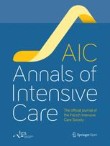To find out more about Indexing services in which Annals of Intensive Care is included, see the 'About' page
Congratulations to the authors of the top downloaded articles published in 2023!
Take a moment to review the full list and read any you may have missed at this link. Also, follow the Journal’s social media channels to get more insights directly from the authors!
Editor's Picks
Cardiogenic shock (CS) presents with low cardiac output and tissue hypoperfusion, leading to high mortality rates despite recent therapeutic advancements. As for other types of shock, a timely diagnosis through ECG, biological and echocardiographic evaluations, and a multidisciplinary team-based management may improve survival.
In this review, Driss Laghlam and colleagues review evidence-based practices for managing patients with ischemic and non-ischemic CS, detailing the multi-organ supports needed in this critically ill patient population.
Proceedings of Reanimation 2023, the French Intensive Care Society International Congress.
Read MoreNew collection: Biomarkers in critically ill patients
We invite authors to submit to our new Collection focusing on Biomarkers in critically ill patients. Key topics we would like to cover in this collection include: early diagnosis, risk assessment, treatment response, biological feasibility, ease of measurement, rapid results, and cost-benefit analysis.
Read MoreNew collection: Long-term outcomes after critical illness
Annals of Intensive Care invites authors to submit reviews and research articles discussing and evaluating long-term outcomes after critical illness and an intensive care unit stay and strategies to mitigate the consequences of critical illness.
Read MoreNew collection: Metabolic and nutritional aspects of critical illness
Annals of Intensive Care is presenting a new Collection of papers aiming to help translate the recent findings into improvements in the quality of care by individualized metabolic and nutritional management.
Read MoreNew collection: The old critical care patient’s journey through the ICU
Annals of Intensive Care is presenting a new Collection of papers highlighting the need for a dedicated approach to caring for geriatric patients in the ICU, including the use of geriatric assessments and tailored treatment plans.
Read MoreArticles
-
-
Can central venous pressure help identify acute right ventricular dysfunction in mechanically ventilated critically ill patients?
-
Biomarkers in pulmonary infections: a clinical approach
-
COVID-19 associated pulmonary aspergillosis in critically-ill patients – authors’ reply
-
Predictive enrichment for the need of renal replacement in sepsis-associated acute kidney injury: combination of furosemide stress test and urinary biomarkers TIMP-2 and IGFBP-7
-
Lung ultrasound in the critically ill
-
Ethical dilemmas due to the Covid-19 pandemic
-
Principles of fluid management and stewardship in septic shock: it is time to consider the four D’s and the four phases of fluid therapy
-
Formal guidelines: management of acute respiratory distress syndrome
-
Hemodynamic parameters to guide fluid therapy
Indexing services
Sepsis is a pressing concern, especially among individuals over 70 in developed countries, given the aging population's vulnerability and high mortality rates. Managing sepsis in older patients requires understanding predisposing factors and vigilance in diagnosing infections because frailty, disease severity, and comorbid conditions may play a pivotal role in outcomes. Thus personalized treatment plans are vital.
In this review M. Ibarz et al. provide a summary of the most crucial aspects to consider when dealing with an old critically ill patient with sepsis.
The most recent studies on the use of β-lactam antibiotics in sepsis patients yielded conflicting results, fueling the debate over their effectiveness. Yang Zhao et al. conducted a systemic review and meta-analysis to evaluate the efficacy and safety of prolonged and intermittent β-lactam infusion in adult patients with sepsis. The study provides insights into antibiotic therapy optimization for sepsis management, emphasizing the superiority of prolonged β-lactam antibiotics infusion over intermittent dosing.
Read MoreCOVID-19 Research Updates
We collect here the most recent research updates on SARS-CoV-2 management and treatment published in the journal to make them easily discoverable to the research community
Professionally Produced Visual Abstracts
Annals of Intensive Care encourages authors to submit a visual abstract along with their manuscripts. As an author submitting to the journal, you may wish to make use of services provided at Springer Nature for high quality and affordable visual abstracts where you are entitled to a 20% discount. Click here to find out more about the service, and your discount will be automatically be applied when using this link.
Read MoreEditor-in-Chief
Jean-Louis Teboul, CHU Bicêtre, Le Kremlin-Bicêtre, France
Aims and scope
Follow
Annual Journal Metrics
-
Citation Impact 2023
Journal Impact Factor: 5.7
5-year Journal Impact Factor: 6.0
Source Normalized Impact per Paper (SNIP): 1.749
SCImago Journal Rank (SJR): 2.061
Speed 2023
Submission to first editorial decision (median days): 7
Submission to acceptance (median days): 91
Usage 2023
Downloads: 1,737,465
Altmetric mentions: 6,851
- ISSN: 2110-5820 (electronic)
